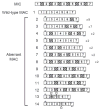A functional role for transposases in a large eukaryotic genome
- PMID: 19372392
- PMCID: PMC3491810
- DOI: 10.1126/science.1170023
A functional role for transposases in a large eukaryotic genome
Abstract
Despite comprising much of the eukaryotic genome, few transposons are active, and they usually confer no benefit to the host. Through an exaggerated process of genome rearrangement, Oxytricha trifallax destroys 95% of its germline genome during development. This includes the elimination of all transposon DNA. We show that germline-limited transposase genes play key roles in this process of genome-wide DNA excision, which suggests that transposases function in large eukaryotic genomes containing thousands of active transposons. We show that transposase gene expression occurs during germline-soma differentiation and that silencing of transposase by RNA interference leads to abnormal DNA rearrangement in the offspring. This study suggests a new important role in Oxytricha for this large portion of genomic DNA that was previously thought of as junk.
Figures




Similar articles
-
The Oxytricha trifallax macronuclear genome: a complex eukaryotic genome with 16,000 tiny chromosomes.PLoS Biol. 2013;11(1):e1001473. doi: 10.1371/journal.pbio.1001473. Epub 2013 Jan 29. PLoS Biol. 2013. PMID: 23382650 Free PMC article.
-
Transposon domestication versus mutualism in ciliate genome rearrangements.PLoS Genet. 2013;9(8):e1003659. doi: 10.1371/journal.pgen.1003659. Epub 2013 Aug 1. PLoS Genet. 2013. PMID: 23935529 Free PMC article. Review.
-
Relaxed DNA substrate specificity of transposases involved in programmed genome rearrangement.Nucleic Acids Res. 2025 Jul 8;53(13):gkaf577. doi: 10.1093/nar/gkaf577. Nucleic Acids Res. 2025. PMID: 40637233 Free PMC article.
-
RNA-mediated epigenetic programming of a genome-rearrangement pathway.Nature. 2008 Jan 10;451(7175):153-8. doi: 10.1038/nature06452. Epub 2007 Nov 28. Nature. 2008. PMID: 18046331 Free PMC article.
-
Programmed Genome Rearrangements in the Ciliate Oxytricha.Microbiol Spectr. 2014 Dec;2(6):10.1128/microbiolspec.MDNA3-0025-2014. doi: 10.1128/microbiolspec.MDNA3-0025-2014. Microbiol Spectr. 2014. PMID: 26104449 Free PMC article. Review.
Cited by
-
The Oxytricha trifallax macronuclear genome: a complex eukaryotic genome with 16,000 tiny chromosomes.PLoS Biol. 2013;11(1):e1001473. doi: 10.1371/journal.pbio.1001473. Epub 2013 Jan 29. PLoS Biol. 2013. PMID: 23382650 Free PMC article.
-
Epigenetic influences of mobile genetic elements on ciliate genome architecture and evolution.J Eukaryot Microbiol. 2022 Sep;69(5):e12891. doi: 10.1111/jeu.12891. Epub 2022 Feb 19. J Eukaryot Microbiol. 2022. PMID: 35100457 Free PMC article. Review.
-
The reverse transcription inhibitor abacavir shows anticancer activity in prostate cancer cell lines.PLoS One. 2010 Dec 3;5(12):e14221. doi: 10.1371/journal.pone.0014221. PLoS One. 2010. PMID: 21151977 Free PMC article.
-
Keeping the soma free of transposons: programmed DNA elimination in ciliates.J Biol Chem. 2011 Oct 28;286(43):37045-52. doi: 10.1074/jbc.R111.276964. Epub 2011 Sep 13. J Biol Chem. 2011. PMID: 21914793 Free PMC article. Review.
-
DNA Transposition at Work.Chem Rev. 2016 Oct 26;116(20):12758-12784. doi: 10.1021/acs.chemrev.6b00003. Epub 2016 May 17. Chem Rev. 2016. PMID: 27187082 Free PMC article. Review.
References
-
- Mochizuki K, Fine NA, Fujisawa T, Gorovsky MA. Cell. 2002;110:689. - PubMed
Publication types
MeSH terms
Substances
Associated data
- Actions
- Actions
- Actions
- Actions
Grants and funding
LinkOut - more resources
Full Text Sources
Molecular Biology Databases

